![]()
![]()
![]()
Use LEFT and RIGHT arrow keys to navigate between flashcards;
Use UP and DOWN arrow keys to flip the card;
H to show hint;
A reads text to speech;
254 Cards in this Set
- Front
- Back
|
Define pattern draping
(2) |
A practical way of making patterns by modelling fabric into a garment
directly on a figure or dress stand. |
|
|
What is pattern draping also called?
(2) |
French modelling;
Moulage |
|
|
How do you go about pattern draping?
(5) |
Soft fabric is pinned or tacked into shape;
Excess cut off: Sew to complete the garment; Unpick and use as a pattern. |
|
|
What are the two methods of pattern-making?
(2) |
Pattern draping;
Flat pattern drafting |
|
|
What are the systems of flat pattern drafting?
(2) |
Proportionate measure system;
Direct measure system |
|
|
Define flat pattern drafting
(1) |
The construction of blocks and patterns on paper on top of a flat surface.
|
|
|
What are the disadvantages of pattern draping?
(5) |
Time consuming;
Lots of fabric; Impractical for many garments; Works best for soft fabrics; Grading problems |
|
|
What are the advantages of flat pattern drafting?
(2) |
Accuracy of sizing;
Speed |
|
|
Define what is meant by "system" in pattern drafting
(2) |
Agreement of vertical and lateral lines on which to record proportions of certain dimensions taken from a human figure
|
|
|
Describe the proportionate measure system
(5) |
Measurements of Bust,
Chest and Hip are used to determine the proportions used to draft a basic block to fit an average figure |
|
|
Describe the direct measure system
(2) |
Measurements are taken directly from the figure;
Blocks are drafted to fit individuals |
|
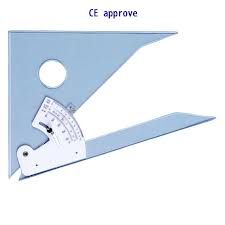
Name and explain:
(2) |
Adjustable set square;
Drawing lines at various angles |
|
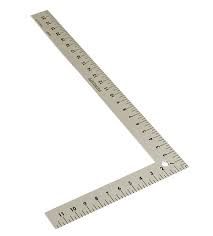
Name, describe and explain:
(6) |
Tailor's square; Metal ruler with two
arms that form a 90 degree angle and has a scale on the back; Simultaneously measures, rules and squares |
|

Name, describe and explain:
(3) |
Graduated square;
Large triangle marked with proportions for drafting by proportionate measure systems; Constructing basic block patterns |
|
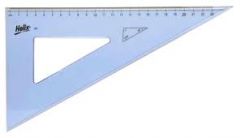
Name and explain:
(2) |
Triangle;
Squaring up lines and curves |
|
|
What qualities does a good set-square have?
(2) |
Transparent;
Both 45 and 90 degrees |
|
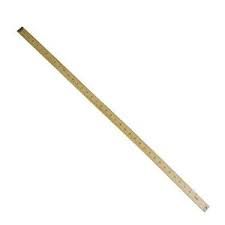
Name and explain:
(2) |
Metre-stick;
Drawing and measuring long straight lines |
|
|
What is a ruler used for in pattern construction?
(2) |
Making seam allowances or
working in small spaces |
|

Name and explain:
(2) |
Curved rule;
used for drawing curves |
|
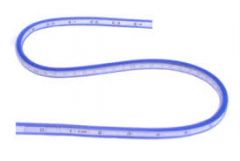
Name and explain:
(2) |
Flexible rule;
drawing curves |
|
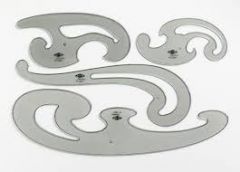
Name and explain:
(2) |
French curves;
drawing curves |
|
|
What are heavy pattern papers used for?
(2) |
Basic blocks;
Pattern grading |
|
|
What are light pattern paper weights called, and what are they used for
(3) |
Marking paper;
First patterns and Markers |
|
|
What are pencils used for in pattern construction?
(2) |
Drafting blocks;
Manipulation |
|
|
What type of pencil is best for drawing curves?
(1) |
HB
|
|
|
What type of pencil is best for labelling?
(1) |
Medium hard
|
|
|
What are coloured pencils used for in pattern construction?
(2) |
Marking style lines and
styling |
|
|
What is calico used for in pattern making?
(1) |
Making up a basic block to test for fit.
|
|
|
What is muslin used for in pattern making?
(1) |
Pattern draping
|
|
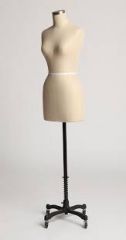
Name
(3) and explain: (5) |
Dress-Form; Figure; Dummy;
Check positions of seams, tucks, panels, etc; Pattern draping |
|

Name and explain:
(3) |
Pattern notchers;
Cut 4mm notch in pattern; Indicates guide marks |
|
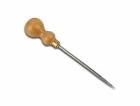
Name and explain:
(3) |
Awl;
Pierces small holes to mark locations on pattern |
|
|
What are pattern weights used for?
(1) |
Used for holding block patterns in place when tracing.
|
|
|
What are pins used for in pattern construction?
(2) |
Pattern draping;
Fitting |
|
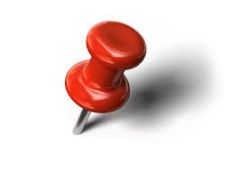
Name and explain:
(3) |
Pushpins;
Pattern pivoting; Transferring style lines |
|
|
What are scissors and shears used for in pattern making?
(1) |
Cutting pattern pieces.
|
|
|
How do you choose which pair of scissors to use in pattern construction?
(2) |
Long, thin blade - paper;
Heavy - hard paper |
|

Name and explain:
(2) |
Stanley cutter;
Cutting heavy-duty kraft board |
|
|
What is a stapler used for in pattern making?
(1) |
Prevents slippage when cutting several layers.
|
|
|
What is a tape measure used for in pattern construction?
(2) |
Measure figure forms;
Measure curves. |
|
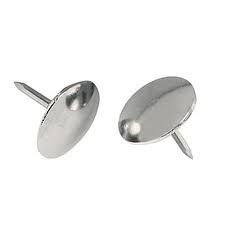
Name and explain:
(2) |
Thumb tacks;
Holding rough pattern pieces over card when making finished patterns |
|
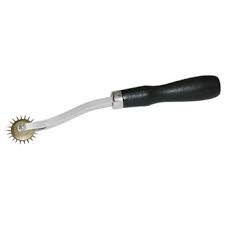
Name and explain:
(2) |
Tracing wheel;
Transferring lines and curves |
|
|
What is magic mending scotch tape used for in pattern making?
(2) |
Closing darts;
Joining sections of patterns |
|

Name and explain:
(2) |
Pattern hooks / Ringers;
Hanging patterns in a workshop |
|
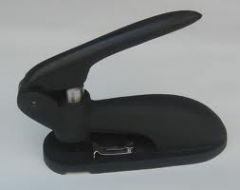
Name and explain:
(2) |
Rabbit punch;
Punches holes for ringers |
|
|
Define the term "Basic block patterns"
(2) |
Pattern forming the basic silhouette for fit and comfort.
No design elements are added. |
|
|
Name the 6 types of blocks
(6) |
Primary/Standard block;
Trade block; Secondary block; Rough styled / Working pattern; Finished Master / Final pattern; Production pattern; Marker |
|
|
Define the term "Standard/Primary block"
(4) |
Foundation block;
Follows lines of figure; Provides correct proportions; Specialized blocks based on it |
|
|
Define the term "Trade block"
(1) |
Adaptation of standard block to suit a company's individual style
|
|
|
Define the term "Secondary block" (1)
|
Basic blocks with additional features such as collars, cuffs, etc
|
|
|
Define the term "Rough styled / Working pattern"
(2) |
A pattern when the primary and secondary blocks are traced and styled;
Doesn't include seams |
|
|
Define the term "Finished master / Final pattern"
(6) |
Working patterns are traced and
seam allowances, pattern markings, pattern information and structural additives are added. Extremely accurate and neat. |
|
|
Define the term "Production pattern"
(1) |
Final form of a pattern after client changes are incorporated.
|
|
|
Define the term "marker"
(3) |
Length of paper with all pattern pieces marked on it. Used for cutting all pieces at one time.
All pattern symbols must be included |
|
|
Which block types can be used for grading?
(2) |
Finished master / Final pattern;
Production pattern |
|
|
Define the term "Pattern drafting/construction"
(3) |
Drawing vertical and lateral lines of dimensions from a body,
and then forming them into the outline of a basic block pattern. |
|
|
Define the term "Pattern designing"
(1) |
Adapting and styling basic foundation blocks to produce any design of a garment
|
|
|
Define the term "Pattern manipulation"
(4) |
Slashing,
spreading or pivoting pattern shapes to alter its shape. |
|
|
Define the term "Pattern adaptation"
(1) |
Changing basic blocks to fit figure disproportions
|
|
|
Define the term "construction lines"
(1) |
Straight vertical and lateral
lines to locate important points for producing basic block patterns |
|
|
Define the term "pattern lines"
(1) |
The outline of the different block sections
|
|
|
Define the term "fitting lines"
(1) |
The assembly position for seams and darts in constructing a garment
|
|
|
Define the term "Pattern grading"
(1) |
Making a set of sizes of the same pattern using a single master pattern.
|
|
|
Define the term "First/primary patterns"
(2) |
The first pattern developed for a design to create a sample before too much work goes into the pattern. Only half is developed, unless asymmetrical
|
|
|
Define the term "pattern cutter"
(1) |
A person or machine that cuts the layers of fabric and marker.
|
|
|
Define the term "pattern chart"
(4) |
A complete record of all pattern pieces within a pattern set;
Includes swatches, sketches and special instructions. |
|
|
Define the term "style analysis"
(3) |
A description of a garment for which a pattern needs to be made.
The designer includes it in the package given to the pattern maker. Includes all measurements |
|
|
What is the design specification sheet?
(1) |
A record of the finishing requirements for a design. No measurements are included
|
|
|
How does one estimate/rate fabric?
(2) |
Lay out pattern pieces as economically as possible (a marker helps)
on a table marked with the specific width of the fabric to be used |
|
|
What is the designer's cost sheet?
(3) |
A record of each design used to cost a garment and
establish a wholesale price |
|
|
Why is accuracy in pattern drafting important?
(2) |
Saves time
and money |
|
|
Define size
(1) |
Dimensions of a pattern or garment made by manufacturers, not an actual person's dimensions. e.g size 32
|
|
|
What is scale used for in pattern drafting?
(5) |
Making a scale of proportions
of the chest, bust and hips to create a pattern |
|
|
Define the word "template"
(2) |
Patterns in one-fifth or half the size of a full size pattern.
It is used in pattern making projects. |
|
|
What does the abbreviation CF stand for?
(1) |
Centre front
|
|
|
What does the abbreviation CB stand for?
(1) |
Centre back
|
|
|
What does the abbreviation BP stand for?
(1) |
Bust point
|
|
|
What does the abbreviation SS stand for?
(1) |
Side seam
|
|
|
What does the abbreviation SW stand for?
(1) |
Side waist
|
|
|
What does the abbreviation SH stand for?
(1) |
Shoulder
|
|
|
What does the abbreviation BP on a sleeve stand for?
(1) |
Back pitch
|
|
|
What does the abbreviation FP on a sleeve stand for?
(1) |
Front pitch
|
|
|
What does the abbreviation SP on a sleeve stand for?
(1) |
Shoulder point
|
|
|
Define the word "scye"
(1) |
The area on the bodice where the armhole is situated.
|
|
|
Name the four labels that you need to put on your patterns
(4) |
Garment name
Pattern part Style number Amount to cut |
|

What does this symbol indicate on a pattern?
(1) |
Grainlines
|
|
|
Where should the grain line symbol be indicated on a pattern?
(2) |
Close to the centre front or back
or in the middle of the pattern |
|
|
Define the grain line of a pattern
(1) |
Straight line to indicate the direction to lay the pattern part on the fabric
|
|
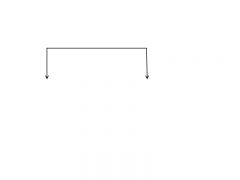
What is this symbol called?
(1) |
Fold brackets
|
|
|
What does a fold bracket indicate?
(1) |
Indicates that the pattern must be placed on the fold of the fabric.
|
|
|
How is a cutting line indicated?
(1) |
Solid line
|
|

What is this symbol called?
(3) |
Sewing line
Stitching line Fitting line |
|
|
What does the sewing / stitching / fitting line indicate?
(1) |
Indicate where the pattern parts must be joined together.
|
|
|
What is a seam allowance?
(2) |
The distance between the fitting lines and the cutting lines or pattern edge.
Indicates the seam width. |
|
|
What are fold lines?
(2) |
Solid lines
to indicate folds |
|
|
What are seam lines?
(6) |
Broken lines
that indicate seam lines of darts, pleats, tucks and pocket positions |
|
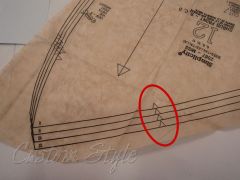
What are these symbols called?
(1) |
Notches
|
|
|
What do notches indicate on a pattern indicate?
(3) |
The matching points aka
balance points for matching of parts of a garment |
|

What does this symbol indicate?
(2) |
Position of gathers
The crosses mark the beginning and end of the gather. |
|

What does this symbol indicate?
(1) |
The ease position
|
|

What does this symbol indicate?
(1) |
Pleats
|
|

What is the solid line with the cross called?
(1) |
Top fold line
|
|

What is the broken line called?
(1) |
Under fold line
|
|

What is the solid line WITHOUT the cross called?
(1) |
Placement line
|
|

What does the arrow show?
(1) |
The pleat fold direction
|
|
|
How are pitches marked on the arm?
(2) |
Different number of notches are made on the front and back pitches on the arm-scye.
These match notch marks made on the armhole. |
|
|
What is the use of pitch marks on styled patterns?
(1) |
Guide for correct hang of sleeves.
|
|
|
Define the bust prominence.
(2) |
The most protruding part of the bust.
|
|
|
What patten features need to be in line with the bust prominence?
(5) |
Panel lines
Darts Pleats Gathers Tucks |
|
|
What is a control dart?
(2) |
Darts found at the shoulder of the front bodice
and waist of skirt. |
|
|
What is the function of the control dart?
(2) |
Gives the appropriate amount of ease over the bust
and posterior |
|
|
Define waist suppression
(3) |
The shaping of side seams
and the darting of a garment to fit a figure at the waistline. |
|
|
How can control darts be changed?
(6) |
Adapted to styled panel lines
Converted to flare, gathers or drapes Reduced in width to give semi-fit to a garment Released for a very loose hanging garment |
|
|
Define squaring
(1) |
Draw lines at an angle of 90 degrees
|
|
|
Define parallel
(1) |
Drawing a line at the same distance from the first line.
|
|
|
Define bisect
(1) |
Divide a 90 degree angle into two 45 degree angles
|
|
|
What is a bisector?
(1) |
The line that divides a 90 degree angle into two 45 degree angles
|
|
|
Define the midway
(1) |
Exactly halfway between two points
|
|
|
What does it mean to divide?
(1) |
To divide a specific distance into a specific amount
|
|
|
What does it mean to pivot?
(1) |
Swinging an arc from a certain fixed point.
|
|
|
What tools can be used to pivot?
(2) |
Compass
Rule |
|
|
What is the pivotal point?
(3) |
A specific point on a pattern that
the pattern is slashed to or pivoted from |
|
|
What does it mean to hollow?
(1) |
To make a hollow bigger
|
|
|
Define the word "blend"
(6) |
Process of smoothing, shaping and rounding
angular lines along a seam for a smooth line and to join seams smoothly |
|
|
What does it mean to reconstruct?
(5) |
To curve
blend soften or smooth the pattern edge |
|
|
Define the term "pattern plot"
(1) |
The act of placing the pattern in line to the other traced section.
|
|
|
What does the testing of patterns entail?
(2) |
Testing a rough pattern on fabric
and correcting it before making a master pattern |
|
|
What is another term for "testing of patterns"?
(1) |
Test fit
|
|
|
What problems can be noticed in a test fit?
(2) |
Distortions of style lines
Badly executed proportions |
|
|
Define "trueing"
(3) |
The blending and straightening of pencil lines
cross marks to establish correct seam lengths |
|
|
What is a bust point?
(1) |
A specific place on the bust and pattern
|
|
|
Define apex
(1) |
The highest location of a mound or pivotal point.
|
|
|
What is a dart?
(2) |
A wedge shape cut out in a pattern
to control the fit of a garment |
|
|
What are the dart legs?
(1) |
The two lines that form an open space at the pattern's edge creating a wedge shape.
|
|
|
What is the dart intake?
(3) |
The space between the two dart legs
to take up fullness and release fabric where needed |
|
|
What is the dart point?
(1) |
The end of the dart
|
|
|
What does cupping the pattern mean?
(3) |
To crease fold one dart let to point
then fold it over to meet the other leg causing a bulge to form |
|
|
What is the purpose of cupping the pattern?
(2) |
To true the dart legs
and establish the seam line shape at the pattern edge |
|
|
What is meant by "dart manipulation"?
(6) |
Moving darts to
form style lines, pleats, gathers, tucks and outline silhouettes |
|
|
What do you need to do if a dart is marked "close the dart"?
(1) |
Close the dart before cutting out the final pattern
|
|
|
Define ease
(2) |
The even distribution of fullness
without forming gathers |
|
|
For what purpose is slashing done?
(4) |
Acquire fullness in the form of
pleats gathers and tucks etc. in a specific position |
|
|
What do spots on the end of slash lines indicate?
(1) |
The cutting of slash lines must not go beyond the spots
|
|

What is this symbol called?
(1) |
Cutting symbol
|
|
|
What does the cutting symbol indicate?
(1) |
The slash line will be cut
|
|
|
Of what are arrows used to indicate the direction?
(4) |
Moving the pattern parts after slashing
Direction of pleats folding The ends of grain Showing positions for gathering in pattern labelling |
|
|
Define flare
(3) |
Fullness built into a garment part
by slashing the pattern piece to specific positions and then spreading the slashed sections at the hemline |
|
|
What is another name for a godet?
(1) |
Wedge
|
|
|
What is a godet?
(1) |
A tapered inset let into a pattern piece to create flare
|
|
|
What is the grain?
(1) |
The direction in which the yarn is woven or knit
|
|
|
What is the warp?
(3) |
The lengthwise grain
Yarn parallel to the selvage It is the strongest grain |
|
|
What is the weft?
(3) |
The crosswise grain
Yarn woven from selvage to selvage The filling yarn of woven fabrics |
|
|
What is the selvage?
(2) |
The narrow, firmly woven and finished strip
on both lengthwise grain edges of woven fabric |
|
|
What is the bias?
(1) |
The slanting or diagonal line across the weave of the cloth
|
|
|
What is the true bias?
(2) |
The angle that folds the warp yarn and weft yarn parallel to each other
The fold which forms a 45 degree angle between the warp and weft |
|
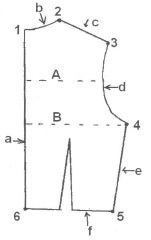
What type of block is this?
(1) |
Ladies' bodice block - back
|
|
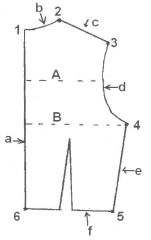
What is at number 1?
(1) |
Centre back nape
|
|
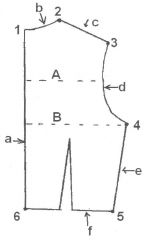
What is at number 2?
(1) |
Shoulder neck point
|
|
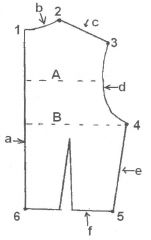
What is at number 3?
(1) |
Shoulder point
|
|

What is at number 4?
(1) |
Underarm point - back
|
|
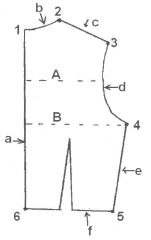
What is at number 5?
(1) |
Side seam waistline point
|
|
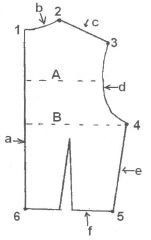
What is at number 6?
(1) |
Centre back waistline point
|
|

What does the line at A signify?
(1) |
Across back
|
|
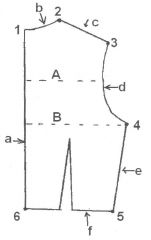
What does the line at B signify?
(1) |
Scye depth line
|
|
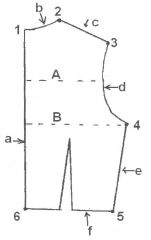
What does the line at a signify?
(1) |
Centre back
|
|
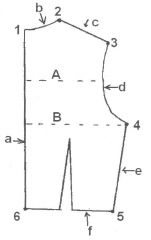
What does the line at b signify?
(1) |
Back neckline
|
|
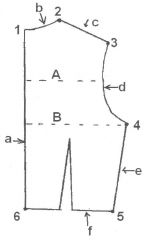
What does the line at c signify?
(1) |
Shoulder seam
|
|

What does the line at d signify?
(1) |
Armhole
|
|
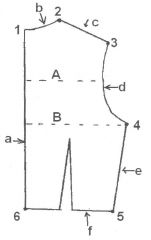
What does the line at e signify?
(1) |
Side seam
|
|

What does the line at f signify?
(1) |
Waist line
|
|
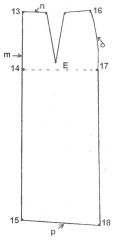
What is at number 13?
(1) |
Centre back waist point
|
|
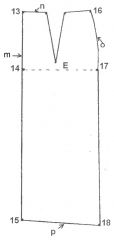
What is at number 14?
(1) |
Centre back hip point
|
|
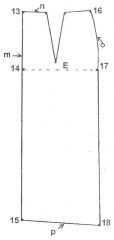
Type of block is this?
(1) |
Ladies skirt block back
|
|
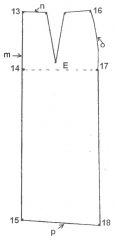
What is at number 15?
(1) |
Centre back hem point
|
|
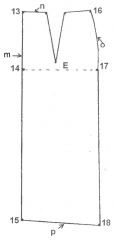
What is at number 16?
(1) |
Side seam waist point
|
|
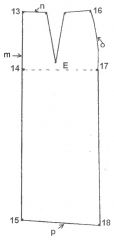
What is at number 17?
(1) |
Side seam hip point
|
|
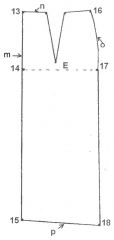
What is at number 18?
(1) |
Side seam hem point
|
|
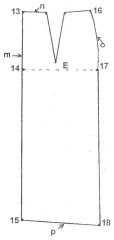
What does the line at E signify?
(1) |
Hip depth line
|
|

What does the line at m signify?
(1) |
Centre back line
|
|

What does the line at n signify?
(1) |
Waist line
|
|
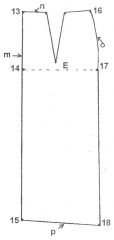
What does the line at o signify?
(1) |
Side seam
|
|
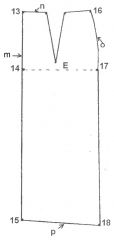
What does the line at p signify?
(1) |
Hemline
|
|
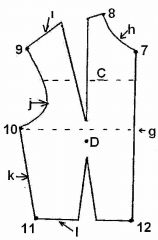
What type of block is this?
(1) |
Ladies bodice block - Front
|
|
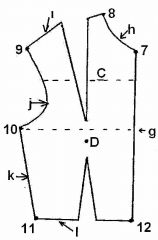
What is at number 7?
(1) |
Front centre nape
|
|
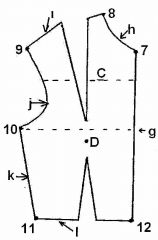
What is at number 8?
(1) |
Shoulder neck point
|
|
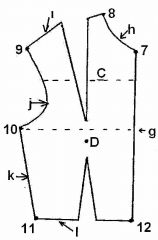
What is at number 9?
(1) |
Shoulder point
|
|
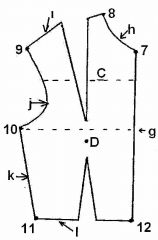
What is at number 10?
(1) |
Underarm point
|
|

What is at number 11?
(1) |
Side seam waist point
|
|
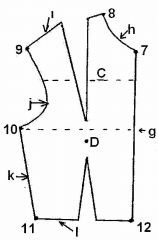
What is at number 12?
(1) |
Centre waistline point
|
|
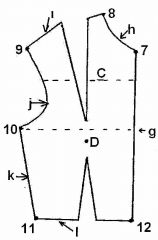
What does the line at C signify?
(1) |
Across chest line
|
|
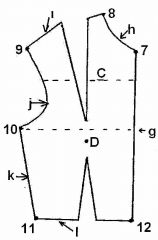
What does the dot at D signify?
(1) |
Bust point
|
|
|
What does the line at g signify?
(1) |
Centre front line
|
|
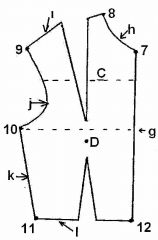
What does the line at h signify?
(1) |
Front neckline
|
|
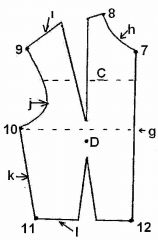
What does the line at j signify?
(1) |
Armhole
|
|
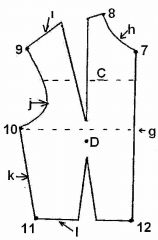
What does the line at k signify?
(1) |
Side seam
|
|

What type of block is this?
(1) |
Ladies' front skirt block
|
|

What is at number 19?
(1) |
Centre front waist point
|
|

What is at number 20?
(1) |
Centre front hip point
|
|

What is at number 21?
(1) |
Centre hemline point
|
|

What is at number 22?
(1) |
Side seam hem point
|
|

What is at number 23?
(1) |
Side seam hip point
|
|

What is at number 24?
(1) |
Side seam front waist point
|
|

What does the line at E signify?
(1) |
Hip depth line
|
|

What does the line at q signify?
(1) |
Centre front
|
|

What does the line at r signify?
(1) |
Waist line
|
|

What does the line at s signify?
(1) |
Side seam
|
|

What does the line at t signify?
(1) |
Hemline
|
|
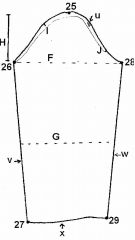
What type of block is this?
(1) |
Ladies' One-piece sleeve block
|
|
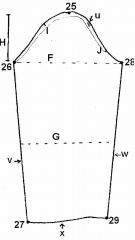
What is at number 25?
(1) |
Shoulder point
|
|
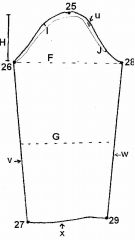
What is at number 26?
(1) |
Back underarm point
|
|
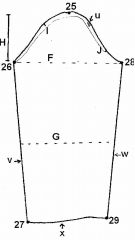
What is at number 27?
(1) |
Back wrist point
|
|
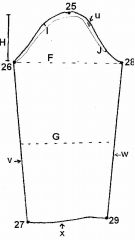
What is at number 28?
(1) |
Front underarm point
|
|
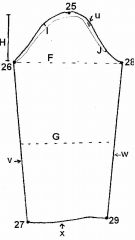
What is at number 29?
(1) |
Front wrist point
|
|
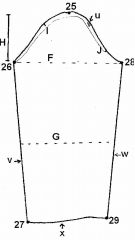
What does the line at F signify?
(1) |
Scye depth line
|
|
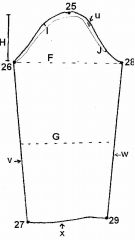
What does the line at G signify?
(1) |
Elbow line
|
|
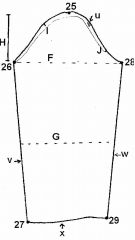
What does the line at H signify?
(1) |
Scye depth line
|
|
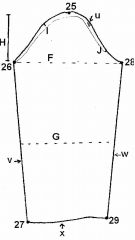
What does the line at I signify?
(1) |
Back pitch point
|
|
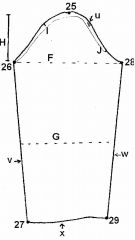
What does the line at J signify?
(1) |
Front pitch point
|
|
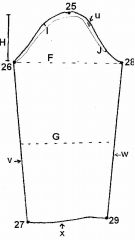
What does the line at u signify?
(1) |
Sleeve head
|
|
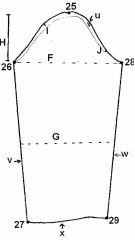
What does the line at v signify?
(1) |
Back underarm seam
|
|
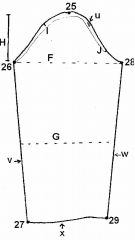
What does the line at w signify?
(1) |
Front underarm seam
|
|
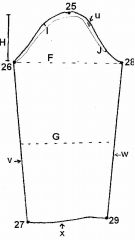
What does the line at x signify?
(1) |
Wrist line
|
|

What does a indicate?
(1) |
Notch
|
|
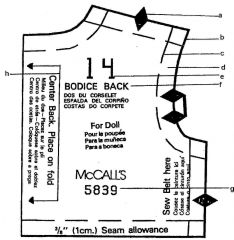
What does b indicate?
(1) |
Cutting line
|
|
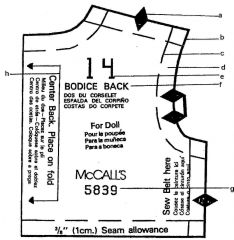
What does c indicate?
(3) |
Stitching line
Sewing line Fitting line |
|
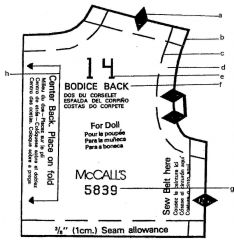
What does d indicate?
(1) |
Seam allowance
|
|
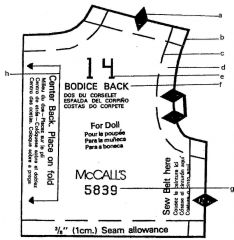
What does e indicate?
(1) |
Size
|
|
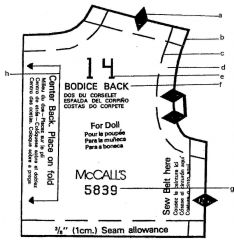
What does f indicate?
(1) |
Pattern piece
|
|
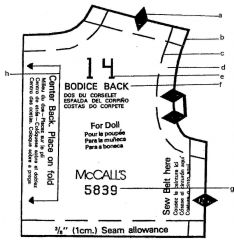
What does g indicate?
(1) |
Pattern / style number
|
|
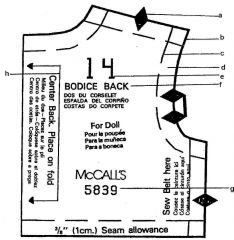
What does h indicate?
(1) |
Place on fold bracket
|
|
|
How do you ensure that you measure accurately?
(4) |
Check tape measure is the correct length
Person being measure must wear well fitting foundation garments Tie tape tightly around waist to determine natural waist Observe disproportions |
|
|
How do you measure the bust?
(2) |
Pass tape over the bust prominence
and the shoulder blades |
|
|
How do you measure the waist?
(1) |
Pass the tape closely around the waist
|
|
|
How do you measure the hips?
(3) |
Taken over the position of the hip bones
around the hip prominence the fullest part of the lower half of the figure |
|
|
How do you measure the hip depth?
(3) |
Distance between the waist and hip
Usually 20cm for people up to 164cm tall Usually 23cm for people over 164cm tall |
|
|
How do you measure across the back?
(2) |
Over the shoulder blades
to where the arms join the body |
|
|
How do you measure the shoulder width?
(2) |
From base of neck curve
to extreme edge of shoulder |
|
|
How do you measure across the chest?
(1) |
Across chest to where arms join the body
|
|
|
How do you measure the back length to waist?
(3) |
From nape of neck
down centre back to waist line |
|
|
How do you measure the front length to waist?
(3) |
From top hollow of neck
at centre front down to natural waistline |
|
|
How do you measure the forearm length?
(3) |
From where arms join body at front
down to the wrist with arms outstretched |
|
|
How do you measure the hindarm length?
(3) |
From where arms join body at back
down to the wrist with arms at an angle |
|
|
How do you measure the skirt-length?
(2) |
As desired
Make allowances for differences in length of the front and back waist to floor |
|
|
How do you measure around the upper arms?
(2) |
Loosely
around largest part of upper arms |
|
|
How do you measure the centre back to bust?
(3) |
From nape of neck
over shoulder down to bust prominence |
|
|
How do you measure the body rise?
(3) |
Sit on hard surface
Measure from waist to surface |
|
|
Why do you measure centre back to bust?
(1) |
Check height of bust
|
|
|
How do you measure the side-seam length?
(3) |
From natural waist
to floor down outside of leg |
|
|
How do you measure the inside leg length?
(2) |
From highest point of the inside leg
to floor |
|
|
How do you measure the knee?
(2) |
Leg slightly bent
Measure loosely around widest part of knee |
|
|
How do you measure the bottom?
(2) |
Around the feet
any width as desired |
|
|
How do you measure a child's chest?
(1) |
Pass tape around chest and shoulder blades
|
|
|
How do you measure a child's seat?
(1) |
Around fullest part of the figure
|
|
|
How do you measure a child's vertical trunk?
(4) |
From the centre on shoulder line
down over chest through the crotch and up to the shoulder line |

